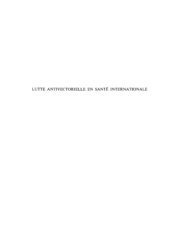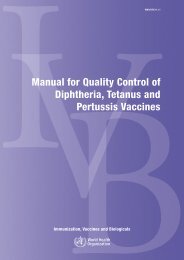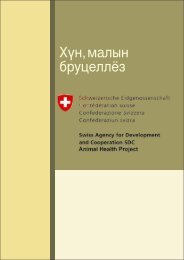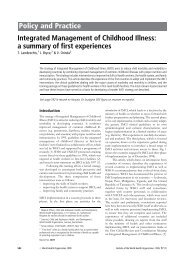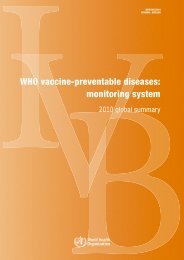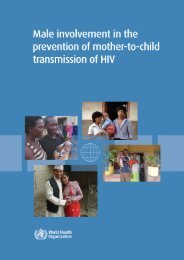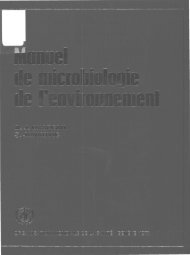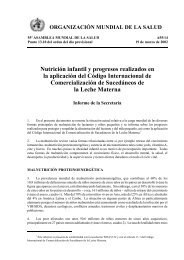Regulatory Situation of Herbal Medicines A worldwide Review
Regulatory Situation of Herbal Medicines A worldwide Review
Regulatory Situation of Herbal Medicines A worldwide Review
Create successful ePaper yourself
Turn your PDF publications into a flip-book with our unique Google optimized e-Paper software.
WHO/TRM/98.1page 29- combined preparations <strong>of</strong> TCM and modern medicine in which TCM medicine is the main component;- cultivated material which traditionally is imported.Category 4- new dosage forms or new routes <strong>of</strong> administration <strong>of</strong> TCM drug;- materials introduced from other parts <strong>of</strong> the country and those for cultivation instead <strong>of</strong> harvesting inthe wild.Category 5- TCM products with new and additional indications.All research on new medicines should provide data on toxicity, pharmacological properties and clinicalresearch, as well as a detailed documentation on the quality <strong>of</strong> the medicinal material and the pharmaceuticalform. For the five categories mentioned above, different requirements have to be fulfilled for the medicinalmaterial as well as for their pharmaceutical preparation. Proprietary medicines included in the nationalpharmacopoeia and new medicines approved by the Ministry <strong>of</strong> Public Health are exempted from clinicaltesting when only the dosage form is changed, such as from powder into gelatine capsules, or from tabletsinto granular form infused with boiling water, without changes in the indications for cardinal symptoms ordosage.The report on the medicinal material should contain the following items in applications for clinical research:purpose <strong>of</strong> research, previous experience or modern research data, source <strong>of</strong> material, cultivation, processing,properties, data based on Chinese pharmacology and experience, efficacy with respect to cardinal symptoms,pharmacological research data, acute toxicity tests, data on mutagenicity/carcinogenicity/reproductive toxicity(only for category 1), draft on quality standards, stability, and the proposed plan for the clinical research. Aseparate application for production should include documentation on quality standards, stability tests, asummary <strong>of</strong> clinical studies, and packaging material.The report on pharmaceutical preparation has to meet similar requirements as the report on medicinalmaterial, depending on the drug category.Technical requirements for pharmacological studies are laid down in a special paragraph. The tests on majordrug effects shall be designed in such a way that the special characteristics <strong>of</strong> the traditional Chinesemedicine are taken into consideration. Two or more methods shall be selected for research on the major drugactions, based on the effects <strong>of</strong> the new medicine on the complex <strong>of</strong> symptoms or the illness. For newmedicines in categories 1, 2 and 3, this research shall be sufficient to verify the major therapeutic functionsand other important therapeutic effects. For new medicines in category 4, two (or more) tests on the majoreffects are required, or else well documented material has to be submitted. For new medicines in category 5,only tests on the major effects <strong>of</strong> the medicine on "new" cardinal symptoms are required. Research on generalpharmacology shall be performed on the nervous system, on the cardiovascular system, and on therespiratory system. Technical requirements for studies on toxicity are also laid down in a special paragraph.Here a difference is drawn between a clinical trial and a clinical verification. Clinical trials shall be conductedfor new medicines <strong>of</strong> categories 1, 2 and 3, and clinical verifications are required for new medicines <strong>of</strong>categories 4 and 5. Clinical trials are divided into three phases, but clinical verification does not have phases.The purpose <strong>of</strong> a clinical trial phase I is to study the reaction and the tolerance <strong>of</strong> the human body to the newmedicine and to find out the safe dosage. <strong>Medicines</strong> in categories 1 and 2 which have either toxic orincompatible compounds have to go through phase I <strong>of</strong> the clinical trial. For dosage determination, the dosageused in animal tests may be used as a reference. The purpose <strong>of</strong> phase II <strong>of</strong> a clinical trial is to obtain anaccurate evaluation <strong>of</strong> the curative effects <strong>of</strong> the new medicine and its safety. In addition, a comparison has tobe made between the new medicine and known drugs, so as to determine its advantages and disadvantages.Phase II consists <strong>of</strong> two parts, the first applies when the treatment is performed and the second when thetreatment is expanded. The dosage used in the clinical trial shall be based on pharmacodynamic tests madebeforehand and clinical facts, or the results <strong>of</strong> phase I. For the selection <strong>of</strong> cases, there are strict standards ondiagnosis, and the diagnosis is based on overall analyses <strong>of</strong> symptoms and signs, the course, nature andlocation <strong>of</strong> the illness and the patient's physical condition, according to the basic theories <strong>of</strong> TCM. For theperformance <strong>of</strong> a clinical trial, either the single or the double blind method may be used, according to need orthe actual circumstances. When the curative effects are determined, four ratings are applicable: clinicalrecovery, significantly effective, effective and non-effective. The evaluation <strong>of</strong> curative effects shall be based onthe clinical



